










The

Dave













The

Dave

Recycle, repurpose, repost. Recycle, repurpose, repost.
Do you have a stockpile of broken vineyard posts? Do you have a stockpile of broken vineyard posts?


Repost processes your posts and gives them a second life as low-cost farming fence posts.
Countless Marlborough wineries have already become part of our sustainable alliance, allowing farmers to fence 7145km of kiwi land, together we’ve saved over 7701 tonnes of treated timber from landfill.
Our fees are 20% cheaper landfill costs, but more importantly, your business will be decreasing your environmental impact by reducing your viticulture landfill waste. Contact us today - it’s a no-brainer!

How does it work?
Head to our website, and fill out the vineyard form. A member of the Repost team will be in touch.
1. If you require on-site processing, we will book a site inspection of our stockpile and/or your intended processing site.
2. Our Terms of Engagement contract will be provided. 3.
We will discuss how to align our respective Health and Safety Management systems. 4.
You will be given a cost breakdown. 5. We will let you know when we can start. 6.
Or you can drop off to Spring Creek or Dillons Point Road. Contact us to book in.
“The redevelopment of our Homestead Vineyard meant a whole load of posts could have gone to waste - but this doesn’t suit our sustainable business model. Enter our mates at Repost to come on-site, process and create new farm posts. Reducing waste from landfill and providing fence posts for farmers, a great combination if you ask me.” Nicole Taylor, Jackson Estate Cellar Door Manager - Benton Wine Group
General Manager:
Marcus Pickens 03 577 9299 or 021 831 820 marcus@winemarlborough.nz
Editor:
Bev Doole 021 069 7836 editor@winemarlborough.nz
Marketing and Communications: Sarah Linklater 021 704 733 sarah@winemarlborough.nz
Events Manager: Loren Coffey loren@winemarlborough.nz
Advocacy Manager: Ruth Berry advocacy@winemarlborough.nz
Advertising: Joanna May advertising@winemarlborough.nz
Grape Grower Directors: Andrew Nation nationa@gmail.com
Bryn Cotching breezemere@hotmail.com
Michiel Eradus michiel@eraduswines.co.nz
Nigel Sowman nigel@dogpoint.co.nz
Tracy Johnston tracy@dayvinleigh.co.nz
Wine Company Directors: Beth Forrest beth@forrest.co.nz
Damien Yvon damien@closhenri.com
Drew Ellis drew@mggcoop.co.nz
James Macdonald james@hunters.co.nz
Pierre Vienings pierre.vienings@boosterwinegroup.nz
Designed by: Blenheim Print Ltd 03 578 1322
Disclaimer: The views and articles that are expressed and appear in Winepress are entirely those of contributors and in no way reflect the policy of the Marlborough Winegrowers. Any advice given, implied or suggested should be considered on its merits, and no responsibility can be taken for problems arising from the use of such information.
This document is printed on an environmentally responsible paper, produced using elemental chlorine free (EFC), third party pulp from responsible sources, manufactured under the strict ISO 14001 Environmental Management System and is 100% Recyclable.

“IT WAS the best of times, it was the worst of times.” This quote from Charles Dickens’ A Tale of Two Cities came to mind when I saw the cover photo for this month’s magazine. Yealands Estate’s viticulturist and winemaker smiling in the vineyard, thrilled with their haul of Marlborough Wine Show trophies in a year that blew the judges away. “The standout variety was Sauvignon Blanc, handsdown. In over 30 years of tasting Marlborough Sauvignon Blanc, I believe the 2024 vintage is the best I’ve ever tried,” enthused guest judge Sam Kim.
The stars had aligned perfectly for growers – a dry winter, a hot summer and, on cue, cool nights in autumn for harvest to lock in the flavours. Exceptional fruit became exceptional wine and there was a lot to celebrate at the show’s long lunch last month when the industry got together to catch up, toast the champions and put aside for a day gloomy thoughts about sluggish sales and tanks still full of 2023 Sauvignon Blanc.
However there’s no denying that for many in the room times are tough, and there is scant relief in the annual Vineyard Monitoring Report released earlier in the same week. What a difference a year can make – 12 months ago November Winepress noted from the 2023 Vineyard Monitoring Report “the second highest economic vineyard surplus on record, at $16,765 per producing hectare, up 44% on the five-year average”. This year it’s down to $4,755 per producing hectare, the second lowest for the vineyard model since 2011/12. What should growers be doing to ride this sort of roller coaster? In Vantage Point (page 6), Mike Insley dissects the 2024 report and shares some strategies on how to navigate the year ahead.
The Wine Marlborough Board is also focused on providing information to help members through the best and worst of times. Sign up for the Pre Harvest summit being held on November 21; read the Board’s new column On the Grapevine (page 19) that draws together data, commentary and analysis on the wine industry; and stay connected with neighbours and the wider industry. Decision-making based on sound information is the key to riding out the worst of times, so arm yourself with knowledge, keep the quality up in the vineyard and winery, and do what needs to be done until the good times come again.
BEV DOOLE
The annual monitoring report provides information to
help plan for the season ahead
MIKE INSLEY
THE ANNUAL Vineyard Monitoring Report for Marlborough, released last month, confirms what many grape producers already knew: the 2023-24 season was tough. Low yields and lower Sauvignon Blanc prices, combined with higher labour costs, higher repair and maintenance and irrigation-related costs, meant the report’s model vineyard recorded its second lowest operating profit since 2011/12 at $4755 per producing hectare. The few bright spots in the report are reduced expenditure on crop protection and fuel, both the result of supply chains returning to “normal” and a little bit of drought assistance in the case of sprays. And the biggest upside of all is the excellent wine quality of 2024, which is always an advantage when selling in highly competitive markets.
The Vineyard Monitoring Report aggregates real data from 50 vineyards across Marlborough ranging from small, grower-owned properties to larger corporate vineyards. It includes a mix of management systems (SWNZ, BioGro). Produced by NZ Winegrowers and the Ministry for Primary Industries and with 20 years of history now behind it, the report provides a robust record of financial performance for a 30ha vineyard model representative of plantings in Marlborough. The vineyard model has adapted over the years to keep up to date with regional changes – this year the area of Sauvignon Blanc was increased to 25.2ha (84% of the vineyard model area) while the area for other varieties decreased. The 2023 data was also reworked to reflect these changes and provide a valid comparison. The report provides an accurate annual benchmarking of vineyard financials and is a treasure trove of information for the wine industry and associated businesses such as valuers, real estate companies and suppliers. The data is vineyard-focused however the fortune of grape producers is invariably tied to winemaker success. Current wine exporting conditions are fragile, with volumes tracking where they were 4-5 years ago. While the return per litre has increased over this time, that hasn’t kept pace with costs and inflation. Ongoing fragile demand is likely to mean supply restraint for the coming vintage both in terms of the grape pricing and volume demand.
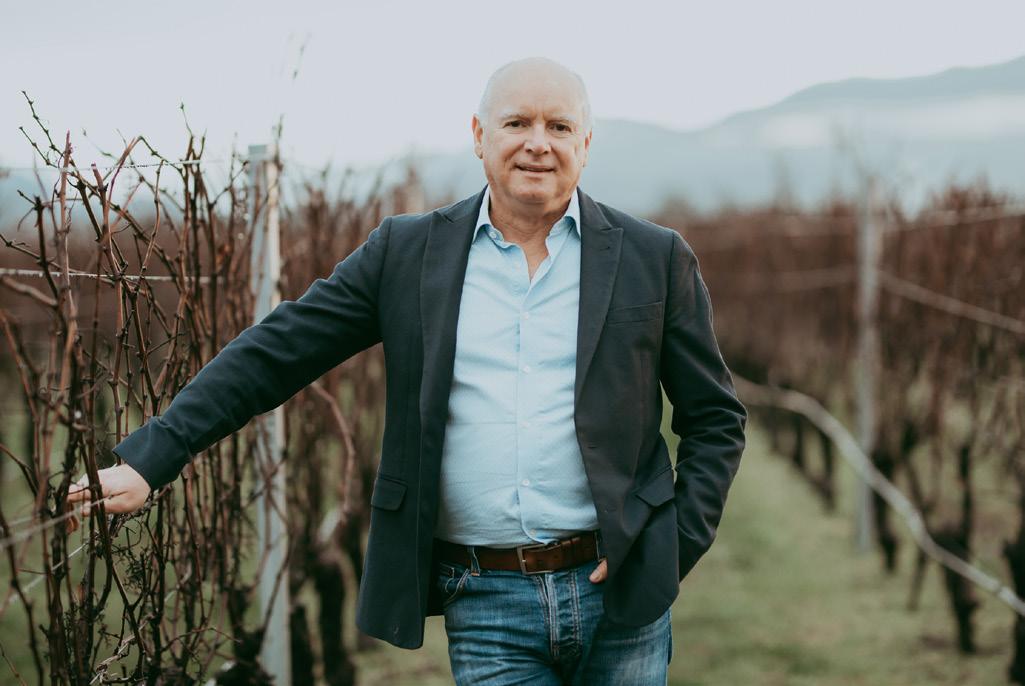
The grape price for Sauvignon Blanc was down $290 (12 percent) to $2,125 per tonne, the first decrease in Sauvignon Blanc prices since vintage 2017. Looking at the potential in 2025 for reduced prices and tonnage restrictions or yield caps, the prudent grower should be reviewing their own situation. Debt management will be key to successfully navigating the year ahead, and strategies such as increasing off-farm income, more owner/grower input into the vineyard, and disposal of surplus assets could be considered. In the June 2024 Winepress, Jim Mercer of Fruition Horticulture discussed a range of onfarm strategies to deal with tough times such as different pruning techniques, increasing mechanisation or machinery efficiency, and deferring non-essential capital investment. For smaller companies this may mean looking at equipment and machinery sharing with like-minded neighbours or friends. I’m also of the view that maintaining vineyard redevelopment plans is important especially if Grapevine Trunk Disease is starting to contribute to yield decline – funding a replanting programme gets harder as yields decrease.
While cautioning against reducing fertiliser unless there’s soil testing and leaf analysis evidence to support that, the prudent grower should be looking at when and how those nutrients are supplied. Applying most of the vineyard’s nutritional requirements as a solid, winter base dressing can be very cost effective, as are early growing season applications of slow-release nitrogen. Whatever your approach to vine nutrition, it should be based on research and evidence. I helped collect the data for the 2024 Vineyard Monitoring Report and the comment I heard most was from individual growers feeling they had little or no power to reduce many of their input costs, especially labour. Perhaps the key word here is “individual”. While buying groups, trading groups and co-operatives take a lot of setting up, acting collectively can also work for the individual member’s benefit, and not just financially. There’s more than a little truth to the saying that “a problem shared is a problem halved”.
Mike Insley is the principal director of Grapesense NZ Ltd, an independent vineyard and viticultural advisory company. mike@grapesense.co.nz 021 229 8157
Wine Marlborough is hosting a Pre Harvest Summit, offering information to help plan for the 2025 harvest. Come and hear three expert speakers, followed by a Q&A session. November 21, 1pm-3.30pm, MRC Theatre
Greg Dryden Fruition Horticulture
Key findings from the past 12 months
What lessons can we take from best and worst performers?
Learning from previous Vineyard Monitoring Reports

VINEYARD COST MANAGEMENT
Stephen Bradley Constellation Brands
Practical tips to reduce operational costs
What options are there for blocks without contracts?
FORECASTING SUPPLY TO MATCH DEMAND
John Wilson JPEW Business Advisory
Global sales trends and forecasts
Balancing supply with demand and downstream impact on grape pricing
Forecasts for vintage 2025 and 2026
2024 Vineyard Monitoring Report: www.mpi.govt.nz/dmsdocument/65616


The Wine Studio is a state-of-the-art contract winemaking facility that specialises in a diverse array of wine styles and winemaking philosophies. Whether you have small batch or require large-scale production, we have the expertise to bring your vision to life. If you’re looking to secure winemaking space for 2025 and beyond, reach out to us at enquiries@thewinestudio.co.nz thewinestudio.co.nz


Table 1: Blenheim Weather Data – October 2024
Degree Days:
1 Growing Degree Days (GDD): Max/Min are calculated from absolute daily maximum and minimum temperatures
2GDD: Mean are calculated from average hourly temperatures
3GDD LTA = 1996/97-2023/24
Temperature
The mean temperature of 14.0°C was 0.8°C above October’s long-term average (LTA). As indicated in Table 2 this was largely driven by the above average minimum temperatures, especially in the first and third weeks of the month. The maximum temperatures over the month were particularly cool during the first 2 weeks of October. The fourth week of the month had maximum temperatures that ranged from 17.2°C to 25.8°C. The warmest maximum temperature of 25.8°C
was recorded on 23 October. The coolest minimum air temperature of 3.4°C was recorded on the morning of 11 October. These above average air temperatures were mirrored with above average soil temperatures at all measured depths (10 cm, 20 cm, 30 cm and 100 cm).
Figure 1 shows how the growingdegree day (GDD) line progressed for the first two months of the 2024-25 growing season compared with the preceding four seasons. The 2011-12 is also included as a contrast as it was a very cool season. The 2024-25 season GDD deviation line for both September and October has been above average. October 2021 followed a similar trajectory to October 2024. The other lines indicate that GDDs were well above average in November 2019, November 2021 and November 2022. NIWA is predicting a high chance of above average temperatures for the 3-months from November 2024 to January 2025. It states that ‘a La Niña Watch remains in effect, with a little over 50% chance that La Niña officially develops by the end of the year. However, this event is likely to be weak and short-lived and might stay below traditional La Niña thresholds.’ This could mean that the current season’s line might follow in a similar fashion to that of 2020-21, 2021-22 and 2022-23, which experienced La Niña conditions.

Figure 1: Normalized Growing degree days for Blenheim: days above (+) or below (-) the long-term average for the period 1 September to 31 December
There were no ground frosts nor were there any air frosts this month. In October 2023 there were 3 ground frosts and no air frosts. October 2020 was the last time that no frosts were recorded for this month. The coldest ground temperature was 0.6°C on 11 and 12 October. The height at which this taken at is 2.5cm above a mown grass surface. To record a ground frost the temperature has to be at or below -1.0°C.
Blenheim recorded 226.8 hours sunshine during October, 98% of the LTA. October can be summarised as either being very sunny, with 10 to 13 hours per day, for a couple of days and then dull and overcast for the next two or three days. The first week of the month recorded particularly low sunshine with 2 days recording less than 1 hour of sunshine! The total sunshine hours from January to October was 2222.3 hours which is the third sunniest 10-month total (1930-2024).
Up until 25 October, Blenheim’s monthly rainfall was just 25.2 mm and was heading to be another below average October. However, on 25 and 26 October there was 55.2 mm with a further 9 mm from 27 to 30 October. This is similar to the Marlborough District Council’s Blenheim site which recorded 84.5 mm. Plant and Food Research has a number of weather stations across the Wairau Plains and Awatere Valley. Depending on the location rainfall varied substantially. At the Wairau Valley site it recorded 227.8 mm, in the Brancott Valley it was 134.1 mm, in the central
Rapaura area it was 129.8 mm and the Seaview Awatere site it was 108.9 mm. This time last year the October rainfall was 32.6 mm and October 2022 was only 16.8 mm. The average October rainfall for 2010 to 2024 is 42.1 mm, with 9 out of 15 years recording below this average. With NIWA’s prediction of La Niña conditions rain is forecasted to be average to below average and that it could be in short but heavy bursts.
October’s average daily windrun was 237.3 km, which was 83% of the LTA. This was as a result of 24 days recording less than the LTA. But there were 7 days with greater than average windrun; 8 October clocked up 508 km with a maximum wind speed of 59 km/hr. This equate to 31.8 knots, which on the Beaufort Wind Scale this is ‘near gale’ conditions.
The moisture deficit is the difference between rainfall and evapotranspiration (ET). For October this year it was -8.1 mm (89.4 mm rain – 97.5 mm ET). The LTA is -46.0 mm indicating that ET is greater than rainfall. With the higher than average rainfall in October there was only a marginal moisture deficit. In October 2023 the moisture deficit was -74.5 mm.
Figure 2 displays the shallow soil moisture (5 to 35 cm depth) at the Grovetown Park weather station for the three previous and current season (the latter is up until 31 October). Between 1 to 24 October the soil moisture declined from 30.6% to 25.5%. However, 55.5 mm rain from 25 to 30
October brought the soil moisture back up to 36.7%, which is a similar level as at the end of October 2021. Without this rain at the end of October the soil moisture would have continued to drop like in the two previous seasons. As mentioned in previous articles, the shallow soil moisture often drops rapidly in October and November.
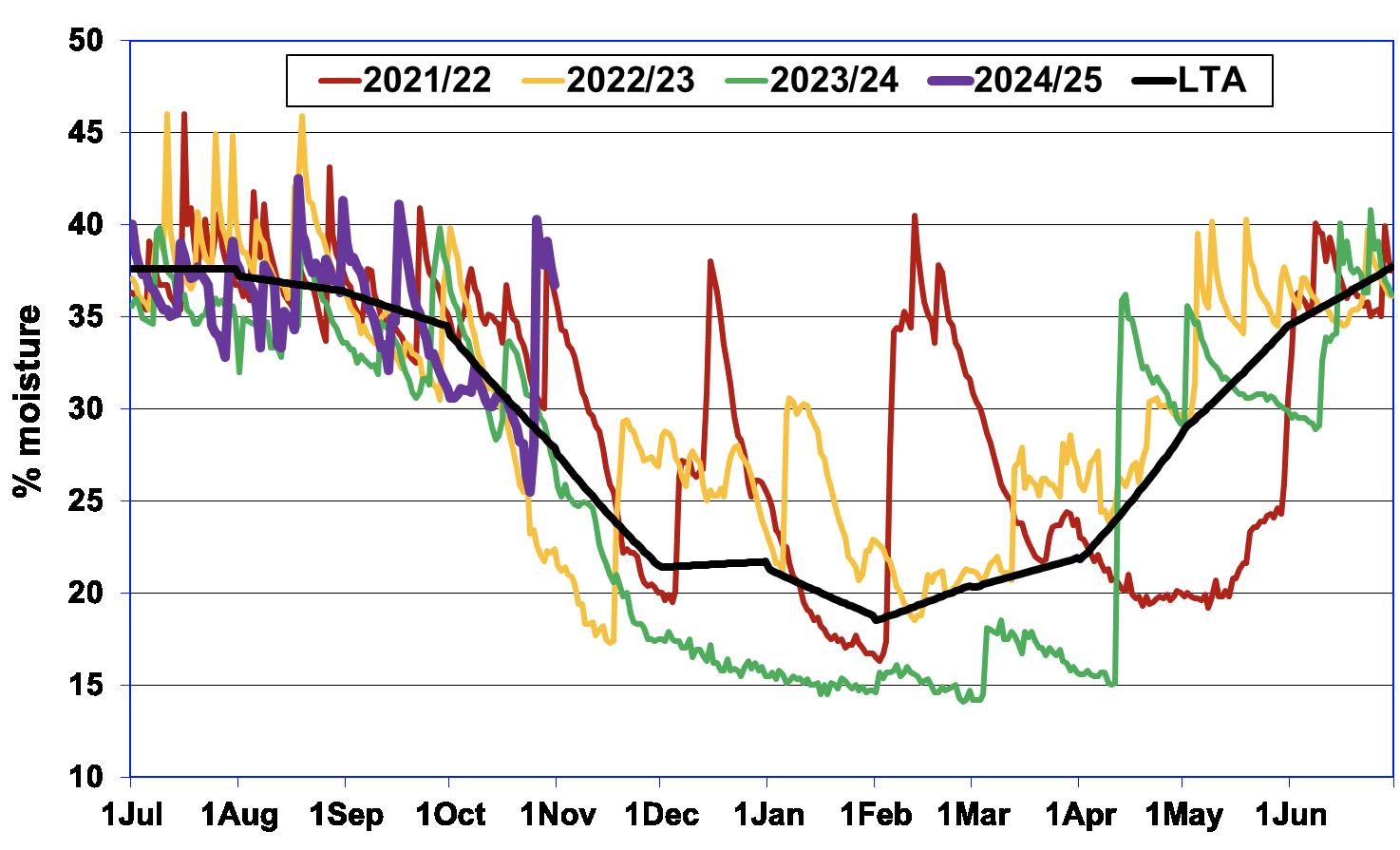




Wine
BEV DOOLE
AS THE 2024 harvest came in, winemakers reckoned this would be an outstanding year and the judges at the Marlborough Wine Show have now confirmed it. Guest Judge Sam Kim got the ball rolling when the gold medals were announced early in October: “The standout variety was Sauvignon Blanc, hands-down. In over 30 years of tasting Marlborough Sauvignon Blanc, I believe the 2024 vintage is the best I’ve ever tried.”
The theme continued at the Wine Show Celebration Long Lunch a few weeks later, when Yealands Estate picked up four trophies for its Single Block L5 Sauvignon Blanc 2024, including the Quay Connect Champion Wine of the Show. “Now and then, you come across a wine that shows varietal purity, sub-regional typicity and outstanding
“We need to keep pushing and being the best we can be, a leader in the world.”
Stu Marfell
concentration and persistency,” says Sam. “This was one of those rare wines that delivered all these qualities, as well as offering fabulous drinkability.”
Chief Judge Stu Marfell says 2024 was a perfect growing season. “We had a dry winter and a hot, sunny summer and then just as autumn and harvest arrived so did the cool nights, locking in the flavour and intensity. The quality of the fruit this year was exceptional; as good as it gets for Marlborough Sauvignon Blanc. And the best that Marlborough can do is the best that the world can do when it comes to Sauvignon Blanc.”
The Marlborough Wine Show is also a showcase for the sub-regions, and this year they demonstrated their distinct characteristics more than ever, says Stu. “In tasting Sauvignon Blanc from the Wairau Valley we really saw the punchy tropical thiols; while the Southern Valleys showed beautiful texture and riper stone fruit spectrum; and from the Awatere Valley we saw the classic racy acidity with crunchy greens, salinity and a sprinkling of thiols. So there really is something for everyone.”
The standout performers were not confined to Sauvignon Blanc. The Giesen Clayvin Pinot Noir 2021 won
PENNY WARDLE
“SALTINESS THROUGH the palate makes a powerfully delicious style of Sauvignon.” That’s how winemaker Natalie Christensen sums up Yealands Estate Single Block L5 Sauvignon Blanc 2024, which took home the QuayConnect Champion Wine of the Show trophy.
Bottled only two weeks before entering the Marlborough Wine Show, the Yealands Estate Single Block L5 Sauvignon Blanc 2024 also won top Sauvignon Blanc, single vineyard, and the Awatere and South Marlborough sub region awards. “I’m super excited the wine was recognised and celebrated in our local show. It’s a great accolade that I’m sure will help with sales,” says Natalie, Yealands Wine Group chief winemaker.
She attributes the Sauvignon Blanc’s success to its origin at one of the most coastal sites on the 1000ha vineyard surrounding Yealands’ winery at Seaview. The grapes were grown under “rugged conditions with supersteep slopes, high winds and low rainfall”. The L5 was top quality from the start, Natalie says. The winemaking team selected it as Yealands’ best, at a blind-tasting from fermentation tanks at the end of this year’s harvest.
“I knew then it was something special with a bit of everything delicious from the site. Beautiful saltiness and the ripe green characters classic for Marlborough Sauvignon Blanc.” A relaxed 2024 harvest played a part, slightly earlier than usual with light crops. “There was
three trophies, including the Fruitfed Supplies Champion for the Southern Valleys. Guest judge Sam Kim was again reaching for superlatives: “Giesen has captured the essence of this seductively sensual grape variety grown on this exceptional vineyard. Clayvin is not only one of the best Pinot vineyards in Marlborough, but also in the entire country.”
He was impressed with the quality of Pinot Noir and Chardonnay entries. “They have been improving with older vine age, better site and clone selection, as well as greater grape growing and winemaking expertise,” he says. “[There were] some impressively alluring wines of world-class.”
International guest judge Elaine Chukan Brown, a wine writer and educator based in California, is keen to see

no time pressure, no disease pressure, incredible fruit. Everything was under control,” Natalie says.
Known for her passion for Albariño – developed while working vintages in the Galicia region of Spain – Natalie also loves making Sauvignon Blanc, which makes up 90 per cent of the Yealands harvest. “It’s what I do, day in and day out. Sauvignon Blanc put Marlborough on the international wine map. Yealands Estate has a great team in the vineyard and winery. I’m proud of our expression of this varietal. Our livelihoods depend on it.”
Natalie learned of the trophy wins during a “very wine-focused trip” to Spain and Italy, tasting native wine varieties and catching up with friends in the industry. She also spent a week in London meeting distributors. A “smallish” 20,000 litres of the winning Yealands Estate Single Block L5 Sauvignon Blanc has been bottled, mostly for export to the United Kingdom. However the wine will be available at the Yealands cellar door and online from late November.
Marlborough continue to grow a range of varieties, including Chardonnay.
“Marlborough makes really distinctive wines across the board, there’s a lifted brightness and freshness and I see that in the Chardonnays too. Previously it felt like these wines expressed either reduction, or oak, or both... as if the winemakers were trying to make sure they could make Chardonnay. And now there’s been this lovely spreading out of style – producers are really exploring which style works with this vineyard or this place. That is exciting to see now, and in terms of long-term potential.”
Looking into the future, Elaine cautions against relying too heavily on the region’s signature grape. “I understand >
Trophy Winners Marlborough Wine Show, sponsored by QuayConnect
Winequip Champion Sparkling Nautilus Cuvée Brut NV
WineWorks Champion Sauvignon Blanc Current Vintage Yealands Estate Single Block L5
Sauvignon Blanc 2024
WineWorks Champion Sauvignon Blanc 2023 & older Saint Clair Wairau Reserve Sauvignon Blanc 2023
Wine Marlborough Champion Chardonnay Current Vintage Saint Clair Omaka Reserve
Chardonnay 2023
QuayConnect Champion Chardonnay 2021 & older Wither Hills Cellar Collection Barrel
Fermented Chardonnay 2021
De Sangosse NZ Champion Pinot Noir Current Vintage te Pā Pinot Noir 2023
De Sangosse NZ Champion Pinot Noir 2021 & Older Giesen Clayvin Pinot Noir 2021
Marlborough Wine & Food Experience Champion Other White Wine Nautilus Albariño 2024
Chandler Glass & Packaging Alternate Style Sauvignon Blanc Mount Riley 17 Valley
Marlborough Sauvignon Blanc 2023
Orora Limited Champion Riesling Wairau River Summer Riesling 2024
Scenic Hotel Marlborough Champion Rosé Kōparepare Marlborough Pinot Noir Rosé 2024
Winebrokers New Zealand Champion Gewürztraminer Mount Riley Marlborough
Gewürztraminer 2024
Label and Litho Champion Pinot Gris Dashwood Pinot Gris 2024
Barrel Finance & Logistics Champion Sweet Wine Tūpari Late Harvest Riesling 2024
Vintech Pacific Best Low Alcohol Wine Clark Estate Block 8 Single Vineyard Riesling 2023
Vit Management Ltd Champion Organic Wine Giesen Clayvin Pinot Noir 2021
Central Express Ltd Champion Wairau Valley Wairau River Sauvignon Blanc 2024
Fruitfed Supplies Champion Southern Valleys Giesen Clayvin Pinot Noir 2021
Circuit Logistics Champion Awatere & South Marlborough Yealands Estate Single Block L5 Sauvignon Blanc 2024
The Coterie Wine of Provenance Yealands Estate Single Block L5 Sauvignon Blanc 2024
NZ Wine Centre Legacy Award, sponsored by Marlborough Research Centre Brancott Estate Chosen Rows Sauvignon Blanc 2016 / 2013 / 2010
QuayConnect Champion Wine of the Show 2024 – Yealands Estate Single Block L5 Sauvignon Blanc 2024
why some areas of Chardonnay are being replaced with Sauvignon Blanc. The cost of land in Marlborough has gone up, the Marlborough Sauvignon Blanc brand is so powerful worldwide, but with any region when people over-specialise, sales will plateau and then start to decrease. For those who can afford it, it’s important to have more options for the long-term picture.” The Wine Marlborough Champion Chardonnay Current Vintage trophy went to Saint Clair Omaka Reserve Chardonnay 2023, and the QuayConnect Champion Chardonnay 2021 and Older was won by Wither Hills Cellar Collection Barrel Fermented Chardonnay 2021. And going further back in time, the NZ Wine Centre Legacy Award, sponsored by Marlborough Research Centre, recognises a single wine across three
vintages. The trophy went to Brancott Estate Chosen Rows Sauvignon Blanc. “It was a brave move by the winemaker to enter 2016, 2013 and 2010 vintages, but the wines have aged elegantly, retained minerality, acidity and complexity,” says Stu. “It was exciting to see how gracefully Marlborough Sauvignon Blanc can age.”
As well as promoting the best of the region’s wine, Stu says the Show strengthens winemaking in Marlborough. “There’s an aspirational element to wanting to achieve, and it drives improvement especially when Sauvignon Blanc is the big one for Marlborough. We don’t want to sit back on our heels – we need to keep pushing and being the best we can be and a leader in the world. The Marlborough Wine Show really helps keep that focus on quality.”
BEV DOOLE
RUNNING A wine show is not just about choosing medal winners, it’s also about nurturing new judges. Stu Marfell, chief judge at the Marlborough Wine Show, says being involved in the show helps develop a career in the wine industry.
“Wine is a blend of art and science and being able to critically evaluate wine is a skill you learn through the judging training,” says Stu. “And that’s being able to look at what’s good as well as what’s bad. You’re always looking to improve everything you do, and being a judge really helps with that ability to look critically at your own wines.”
Stu says there’s a strong focus at the Marlborough Wine Show to bring on new judges, starting with stewarding behind the scenes. “We had a few new stewards this year who’re keen to dip their toe into wine judging; some new associate judges who’ve stepped up from stewarding; and also some new senior judges. It’s really nice to see that progression through.”
One of those stepping up was Dave Foes, Operations Winemaker at The Coterie, who was previously a steward at the 2023 show. “As a steward you help set up the doubleblind system that ensures the judges never know which label they’re tasting,” says Dave.
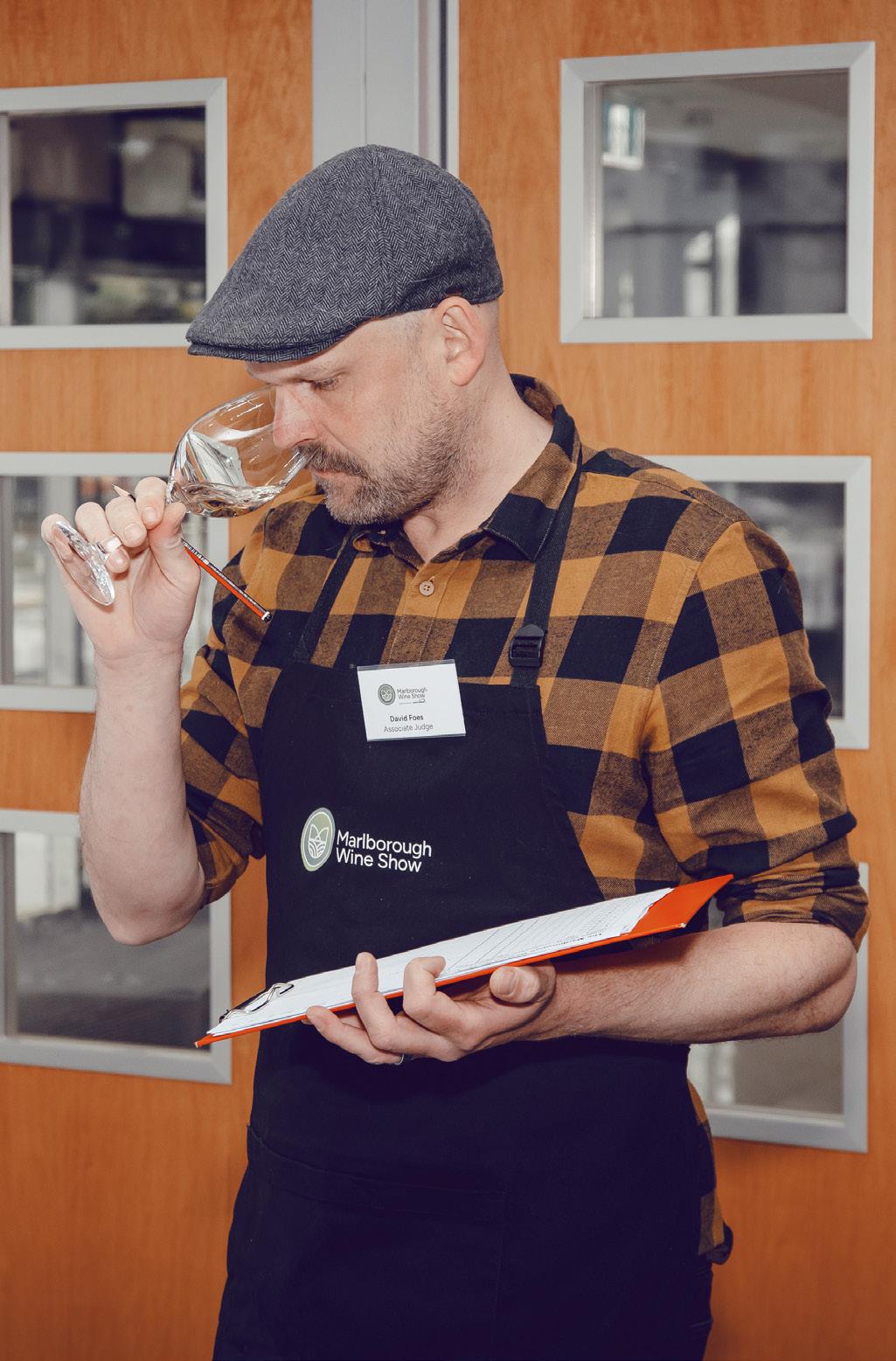
“Meeting the guest judges and getting to know them was a real highlight.” Dave Foes
He enjoyed seeing the changing styles of wine. “Consumer trends change, for instance Chardonnay that was big and bold and buttery would once have been given a gold medal, but nowadays it’s a bit more restrained. There’s a dynamic progression in wine styles and hopefully the judging process is capturing and championing that.”
“There’s a very distinct line between the back room and the front room where the judging takes place. No bottles are ever allowed to go into the front room, and none of the judges are ever allowed to go into the back room.” Each class is poured and put together in a specific order in the back room, then the stewards take them out to the judging tables.
It’s quite a process to get your head around to understand the system, says Dave, but there are great learning opportuntities. Stewards can listen in on the judges’ comments, try the wines, and get an insight into what it takes to be awarded gold. This year Dave successfully applied to become one of six associate judges. “As an associate you talk about the wines with the rest of the panel and your opinion is taken into account, but at the end of the day the senior judges decide what gets put forward as a gold.”
He also relished the chance to hear the thoughts of guest judges and industry veterans Sam Kim and Elaine Chukan Brown. “Having their perspectives in the show and meeting them and getting to know them was a real highlight, as was the camaraderie with the other judges. Getting away from my office and hanging out with them for three days was brilliant.”
Stu picks up on that point as a key benefit of becoming a judge: “You meet so many people doing judging – other winemakers, viticulturists, wine writers, which becomes a network of people to tap into throughout the year. Whether that’s to ask a question about changes happening in the winery, or you come up with an idea and wonder if someone’s done it before – you’ve got this network where everyone is pretty open and you can use that knowledge back in your day job.”

“The weather is something we all talk about, and at times complain about, but I can’t recall receiving a complaint about Met Report.” Rob Agnew



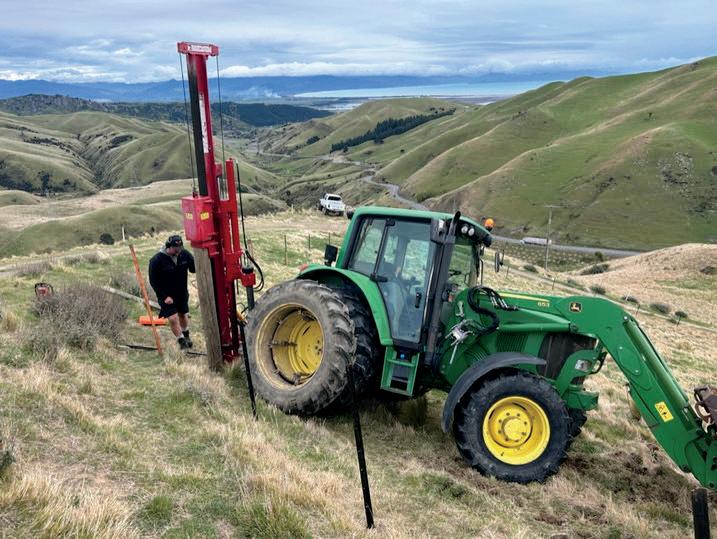

FIVE PEOPLE from different parts of the industry received Wine Marlborough Lifetime Achievement Awards at the 2024 Wine Show celebrations. Ben and Frances Wickham of Ormond Nurseries, climate scientist Rob Agnew, and Daniel and Adele Le Brun of No.1 Family Estate were acknowledged for their long involvement and efforts to make the industry what it is today.
“It’s no secret that Marlborough is home to many winemakers and winegrowers who’ve been working hard at their craft for some decades now,” says Wine Marlborough general manager Marcus Pickens.
“Alongside them, we have experts in many areas, including the likes of our scientists and horticulturists who have helped along the way, and continue to do so.”
For Rob Agnew, this has involved recording and interpreting meteorological data, providing a wealth of information to help local winegrowers make the best decisions in the vineyard. As well as writing the Met Report for Winepress for three decades, he produced VineFacts, chaired the NMIT Viticulture Advisory Committee, and was a Plant and Food Research scientist until his retirement earlier this year.
Ben and Frances Wickham of Ormond Nurseries have led the way in grape propagation in Marlborough since 1995 and their business continues to innovate. This year they opened a vertically integrated nursery facility capable of producing two million vines a year, and designed with strict biosecurity protocols front of mind. They are a powerful duo, with Ben the nurseryman and Frances running the business.
Daniel and Adele Le Brun have been pioneers in Marlborough sparkling wine, identifying qualities in the region that enabled them to produce world-class wine with the classic varieties Chardonnay, Pinot Meunier and Pinot Noir. The couple helped set up Mèthode Marlborough, a grower-led collective to champion bottle-fermented sparkling wine from the region. They also created one of the first underground caves to slowly mature their wine. In 2021 Daniel and Adele were made Fellows of New Zealand Winegrowers; in 2006, they were awarded the Chevalier of Agricole for Services to Agriculture, and in 1987 they received the equivalent of a French Knighthood, the Chevalier Order of Merit for Services to France.
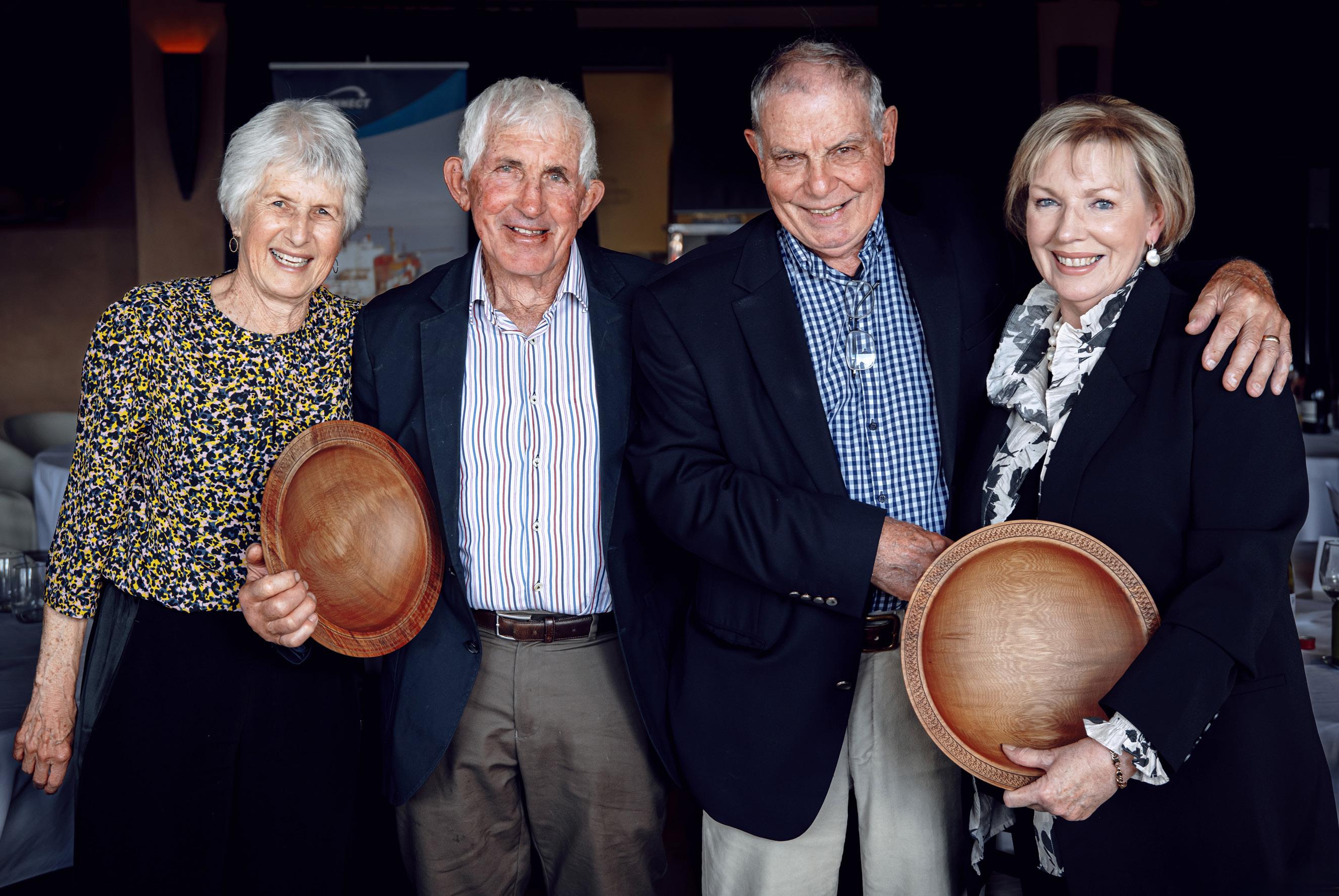
“The
grapevine industry
is very much in the background, so being recognised with this award is a huge honour.”
Frances Wickham
“I’m really pleased to have contributed to lifting the bar for sparkling wine, it’s a lasting legacy for Marlborough.” Daniel Le Brun
More about the Lifetime Achievement Award recipients: Rob Agnew, Winepress April 2024 issuu.com/winepressmagazine/docs/winepress_-_april_2024
Ben and Frances Wickham, Winepress October 2024 issuu.com/winepressmagazine/docs/winepress_-_october2024
Daniel and Adele Le Brun marlboroughwinenz.com/press-releases/no1-family-estate



New Zealand agent for Netwizz and Olinet netting applicators. Slim, standard and hydraulic mast models available.

LAST YEAR was a time of celebration and reflection on the success of Marlborough reaching the significant milestone of 50 years as a wine growing region. It was a stellar ride to global recognition, and it would be easy to fall into the trap of thinking the wave of success would continue forever. How quickly we have had to readjust and reset our expectations over the past 12 months. The situation has changed for many who may be experiencing a slowing rate of sales, too much stock, changing consumption preferences, vineyards reaching replacement age or maybe having a varietal mix that isn’t optimal.
Your Board is committed to making a difference, and sharing information is key. However to take up information and make use of it, members have to be on the lookout for it, and connected and engaged with the industry. Our recent Snapshot of the Marlborough Wine Industry survey provided important insights and led to the Industry Outlook published in September Winepress. Continuing the theme of information sharing, a Pre-Harvest Summit will be held on November 21 with speakers providing insights on vineyard financials, cost management in the vineyard and forecasting supply to match demand.
We brought WinePRO to the region with Expertise Events and Marlborough District Council in June and are planning WinePRO 2026. More than 1450 unique visitors visited 100 exhibitors over two days. Approximately 300 people chose from 25 sessions in the WinePRO Conference. It was a success, and the positive encouragement and feedback will enable the next event to be even better.
Significant investment in workforce planning was supported by funding from the Ministry of Business, Innovation & Employment, NZ Winegrowers, and MRC. A first-of-its-kind Skills Report for the wine industry was completed by BERL and released in June. The Food and Fibre Centre of Vocational Excellence and Muka Tangata – Workforce Development Council for People, Food and Fibre, regard this report as an exemplar and have asked to work with the industry to further develop understanding of wine industry roles, look for comman ground with similar primary industries and produce practical resources to help attract and retain workforce.
We are embarking on a regional water resilience project and joined forces with Federated Farmers to submit to the Marlborough District Council Long Term Plan. Our vision is for a regional response to a changing climate, one where there is enough adaptability in the system for all water users to win. We are at the beginning of a long project, and you will hear more about this.

It’s well known that Wine Marlborough deliver great events, but costs are increasing far faster than revenues. This year the Board agreed to a commercial audit of the Marlborough Wine & Food Festival by an independent expert. The review found the event was extremely well managed, with a clearly defined purpose and measurable strategic objectives. The Board is assessing three options for after the 2025 Festival: refine and continue delivery inhouse; outsource delivery of the event and deploy staff to other priorities; or wind up the event.
The Geographical Indication boundary has been a topic of discussion, with some feeling the boundary is too large and threatens the potential quality and volume of what can be called Marlborough wine. We’re looking closely at this issue and will consult members to gather opinions. Any change would need significant education and patience.
Wine Marlborough continues to be a hub for gathering problem-solvers together through projects such as the Circular Wine Group working on industry waste and greener energy solutions; the Wellbeing Group, who collaborate with Farmstrong and continue to promote the need to balance work with wellbeing; the Young Viticulturist and Young Winemaker committees who champion our newer talent pools; and the Wine Tourism Steering Group who work to connect all involved in making our destination as good as it can be.
I want to thank all those who contribute their time to advance our industry. Also a huge thank you to all current and past Board members and Wine Marlborough staff for their support, and I encourage any other “big picture” thinkers to join us in shaping our next 50 years.
The full 2024 Marlborough Winegrowers Annual Report is on the website from November 6 marlboroughwinenz.com
Each month the Wine Marlborough Board will bring you insights into the state of the industry, drawing from commentators, market commentary and observations regarding winegrowing in Marlborough. It is important all in our sector are fully informed and aware of any ways they might improve or react to local, regional and global trends.
Viticulture – looking back
• Frost Damage –The October frost season has left its mark with some obvious areas of damaged or dead shoots now showing themselves. Check out the BRI extension output report 2023 and the webinar provided by the BRI regarding recovering from frost damage and effects of foliar treatment.
• VineFacts – Budburst is slightly ahead of the 10-year average in all sub regions.
• Soil Moisture – The Tasman Crop Met Report indicates that shallow soil moisture was below average at only 31% by the end of September at the Grovetown weather station and we received only 75% of the long-term average rainfall between January and September 2024. Early watering will be essential so as not to deplete soil reserves too quickly. Check your irrigation regulations under your resource consent to be sure of not overwatering and putting pressure on the water resource.
• Aquifer Levels – Many of the Marlborough aquifers have not recharged fully and are still sitting below average. Winter 2024 was marginally drier than the long-term average, continuing the lower rainfall trend. Be vigilant with irrigation checks and fix any leaks or broken pipes as soon as possible. Check your irrigation regulations under your resource consent to be sure of not over-watering and putting pressure on the water resource.
Viticulture – looking ahead
• Bunch Counts – Inflorescences are now present across most varieties and regional bunch counts are under way. Consider counting your own set of vines and being aware of potential crop level. See article in VineFacts 10 October 2024 on how to improve yield estimation. Consider shoot thinning for crop control – managing crop load can be done quickly and efficiently now with shoot thinning to reduce bunch
numbers on vine. Small green shoots can be manually removed at the cane by just bending/snapping the shoot off. Use fist-spacing as a model of good distance between shoots. For best shoot positioning, twist off the shoots in-between those at fist-distance to reduce the cluttering of shoots and bunches. Or remove the unders – twist off the shoots pointing downwards on the cane, those considered less well positioned.
• Spray Season – Be sure to discuss what is essential in your spray programme and what could be considered later in the season if we are facing a dryer or wetter than normal year. Take a good look at any disease occurring in your vineyard and surrounding sites that existed last year such as powdery mildew or mealybug to make sure you are addressing site-specific pressures. Shoot positioning may also help with good open canopies for effective spray access during the season. Read the spray drift rules included in the 4 November Wine Marlborough newsletter.
Ciatti Global Wine & Grape Brokers supply monthly reports that analyse nine wine producing countries (including NZ) and current market pricing for key varieties. Their October report states: “The value and volume of New Zealand’s wine exports declined in the 12 months to June 2024, as a better January-June period struggled to offset a large decline in the second half of 2023. Leading markets the US, UK and Australia have been buying less volume.”
The table below highlights New Zealand’s production and sales imbalance over the past 10 years. The Ciatti report reiterates the pressure we are feeling as exports remain slow on the global stage. The report summarises the global situation well and is worth reading in its entirety. www.ciatti.com
For further insights and information register to attend the Wine Marlborough Pre-Harvest Summit at the MRC Theatre on 21 November from 1pm-3.30pm. See details in the Wine Marlborough e-newsletter.

PENNY WARDLE
ON A RIDE through the vines, Marlborough secondary students learned there’s more to growing and making wine than hard, physical work. Kat and Tayla Walker of Explore Marlborough Wine Tours organised the day on bikes for the Graeme Dingle Foundation Marlborough Career Navigator programme. The course builds skills and confidence for a successful transition to higher education or employment.
Tayla, a previous Career Navigator student now mentor, says they aimed to demonstrate that there is more to the wine industry than meets the eye. “From viticulture and winemaking to tourism, marketing and logistics, there are many avenues to explore,” she says.
The day began with an introduction to wine tourism for the 17 Year 12 and 13 students from Marlborough Boys’ College, Marlborough Girls’ College, Queen Charlotte College, Rai Valley Area School and Richmond View School. Explore Marlborough last year hosted 5000 people on biking and driving tours around vineyards and wineries, and Tayla spoke from her experience and brought the job to life with stories about hosting clients.
Next stop was Forrest Estate, where general manager

and winemaker Beth Forrest shared a lifetime of knowledge and insights about growing, making and marketing wine. She described the many roles in the industry, the excitement of wine career travel and the buzz of coming home to put new techniques into practice.

While too young to have a tasting, the Career Navigator students experienced wines’ distinctive aromas and got a rundown on how the Forrest cellar door operates. “The students were so inquisitive,” says Kat. “They walked the catwalks, asked to explore a storage area, poked their heads into the grape press and asked questions about technical equipment which they thought was very cool.”
Throughout the day the students learned about the grape growing season and how climate and environment shapes the Sauvignon Blanc that dominates the Marlborough industry. A highlight was meeting 2022 Career Navigator graduate Chloe Vervaart, who is now thriving as a Forrest vineyard operator and winery cellar hand. Chloe said that as a Year 12 student at Marlborough Girls’ College she knew she didn’t want to go to university, liked the outdoors and wanted to stay in the region. But she had no idea what job to go for.
Wine industry experience and mentoring through Career Navigator pointed Chloe in the right direction. Last year she followed up by enrolling in the Nelson Marlborough Institute of Technology cellar operations course, which opened the door to the Forrest job.
The next stop for the group was Cloudy Bay, where vineyard sustainability and operations manager Brock Campbell led a session on managing vines to make quality wines. Brock is a Career Navigator mentor and gets a serious buzz out of helping students find their way to a meaningful career. Kat says his hands-on approach gave the students a chance to engage and ask questions and get a clearer understanding of career possibilities.
“It was good to learn new things and network with people telling us about wine industry positions.”
Zoe Da Costa, a Year 13 Marlborough Girls’ College student and graduate from the 2024 Career Navigator course, says although she’s not a big fan of biking she had a lot of fun on the cycle tour career day. “It was good to learn new things, meet new friends and network with people telling us about wine industry positions.”
Zoe is training to be a real estate agent, with the goal of achieving her sales licence once school exams are over. Plan A is to work as an agent and later complete a degree in property law. She says the cycle tour career ride provided a possible plan B: working in wine sales and marketing before heading to university.

Zoe Da Costa
“We heard that wine companies are recruiting for a whole variety of jobs, handing out scholarships and providing internships, which I found really interesting,” Zoe says.
Kat was happy to hear that at the Career Navigator graduation ceremony some students said their day on the cycle tour had got them thinking about a career in the wine industry.




COLDSTORES LIMITED
Let us take care of all your controlled Temperature storage requirements:
◆ Custom controlled area
◆ Approved Transitional Facility for unloading of Imported Containers
◆ Over 60,000 cubic metres of storage spread over two sites.
◆ Chilled storage available during vintage for handpicked grapes.
◆ Sophisticated monitoring equipment ensures your product is kept at the optimum temperature.
◆ We could lease you a small room for your exclusive use to suit your particular temperature requirements (0 o C to + 30 o C).
◆ We store bottled wine, barrels of wine and new plants awaiting the opportune time to plant.
◆ Individual rooms available to grow new budwood.




Liv Bishop is used to pushing herself, whether it’s competitive mountain biking or working in the vineyard
If you’re constantly in uncomfortable situations it eventually gets easier.”
IT WAS Albert Einstein who famously coined the phrase: “Life is like riding a bicycle. To keep your balance, you must keep moving.” For Marlborough viticulturist and avid mountain biker Liv Bishop, hurtling down a hill on two wheels provides many more metaphors. “I’ve definitely learned over the years, both on my bike and in life, that there are benefits to pushing yourself out of your comfort zone,” Liv says. “If you’re constantly putting yourself in uncomfortable situations it eventually gets easier. It may be awful at the time, but that pain leads to growth and the feeling of satisfaction afterwards makes it all worthwhile.”
As a kid growing up in Marlborough, Liv and her sister were “bribed with ice cream” to go bike riding with their parents. While she found it hard to keep up when younger, her power and skills developed in her teens and mountain biking became a favourite pastime. She won many regional and national titles and in her final year at Marlborough Girls’ College she toured Australia and Europe with the New Zealand Mountain Biking National Performance Hub and was named her school’s Sportsperson of the Year in 2017.
Liv successfully juggled her studies and racing commitments but didn’t give much thought to what she wanted to do after school. With a love for the outdoors, she decided to try her hand as a vineyard operator and picked up a job at Jackson Estate. She enjoyed the all-round experience of working for a small winery but could see the


Liv Bishop
benefits of being in a larger company and soon found a role with Delegat. Her strategy paid off and over the past four years she’s progressed from operator to vineyard operations supervisor, while studying a graduate diploma of viticultural science through the Eastern Institute of Technology. Over the past few months, her responsibilities have increased to include the day-to-day running of some 320ha of vineyards in Waihopai, Northbank and Tuamarina.
“It’s been a busy time with loads of pressure, especially juggling full-time work with part-time study – everything seemed to be due during harvest,” she says. “Fortunately I work with some great people, so while there were a few times I had to prop my eyelids open to stay awake, I’ve felt very supported through it all.”
While Liv enjoys the practical side of her role – operating the machinery, vine care and vineyard maintenance – management and theory have been more of a learning curve. Never one to shy away from a challenge, she’s competed in the Marlborough Young Viticulturist Competition for the past two years, coming third and second place respectively. “My colleagues and family often tease me for being a nerd,” she says.











Wine exporters need to face up to
CATHIE BELL
MARLBOROUGH COMPANIES putting off thinking about Environment, Social and Governance (ESG) requirements have their heads buried in the sand, say two people working in this space. At a Climate Action Marlborough activation day, &BLOOM chief executive and founder Sydney Straver and Marlborough Chamber of Commerce economics advisor Alistair Schorn encouraged participants to focus on ESG measures.
“ESG can enhance brand reputation, attract investors, and foster customer loyalty.”

While Sydney doesn’t have any Marlborough wine clients at this stage, she says she is “having conversations with plenty”.
ESG is used to assess the sustainability of a company, and this accountability is increasingly required by overseas buyers. Environmental, Social and Governance responsibilities are seen as the three major challenges facing corporations.
Sydney Straver says it’s especially important because of the export exposure of the Marlborough wine industry. “In Europe, it’s no longer just about price and quality… it’s about price, quality and sustainability. Large companies and SMEs are already mandated to report on sustainability by the Corporate Sustainability Reporting Directive (or CSRD), where disclosure on such non-financial information is as important as financial information. “So, we see this shift towards more transparency, more disclosure, more ambitions on sustainability, to really secure that licence to operate and grow in the European market and beyond.”
Sydney says companies are expected to report on ESG performance annually, either as part of their annual report or through a standalone sustainability report. Certifications such as SWNZ and B Corp may be a starting point for sustainability reporting, but she says integrating ESG into business strategy requires a deeper, more structured approach to measure and report on broader sustainability impacts, beyond what certifications alone can offer.
In New Zealand, the External Reporting Board has established a Sustainability Reporting Board to provide a framework for non-financial disclosure. And across the Tasman, the Australian Government has mandated Australian Sustainability Reporting Requirements for large and medium-sized entities from 2026 onwards.
Sydney and Alistair are both emphatic that wine companies need to get their head around ESG quickly.
Getting on board with ESG provides several strategic benefits for a wine company, including securing the licence to grow, says Sydney. “It demonstrates commitment to the biggest transformation of our economy in human history, namely the shift towards a future-proof one. This can enhance brand reputation, attract investors and foster customer loyalty, which is crucial for long-term growth.”
She say Marlborough wine companies need to perform “double materiality assessments”, where financial materiality (impacts of the people or the environment on enterprise value) and impact materiality (impacts of the entity on people or the environment) are looked at.
“This helps you narrow down how sustainability is relevant for your business. For wine growers, this typically consists of the following themes: energy management, water management, packaging life cycle, selling practices and product labelling, and supply chain management.”
Alistair says the ESG requirements boil down to “what your customers want and what your investors want”. About 30 per cent of Marlborough companies in a recent Chamber of Commerce survey are reporting ESG measures. These would be bigger export-oriented businesses in primary industries, he says, because their markets are requiring it now. But smaller operators need to put it on their work programme too. Alistair says Scope 3 requirements, which reach into the sustainability of a company’s supply chains, will make ESG reporting necessary and are due in the next two to five years, depending on jurisdiction. “It affects smaller companies here because big companies need to have clarity from their suppliers to meet ESG requirements… The rubber is going to hit the road when Scope 3 reports are needed,” he says.
CATHIE BELL
SETTING UP as a B Corp kick-started the ESG journey for Marlborough wine company Tiraki, says owner and winemaker Josh Hammond.
B Corp certification measures a company’s social and environmental impact. It aims to build trust with consumers, communities and suppliers and help attract and retain workers. Companies apply to be assessed and certified, and then re-certified every three years, using that process as a tool for continuous improvement.
“The resources that B Lab [the organisation that awards B Corp] freely provide are a great starting point for any business to understand their environmental and social impact,” says Josh. “The business impact assessment tool is a well thought out questionnaire covering environment, workers, customers, community, and governance. It’s a great framework for understanding your business’s current ESG impact and where you can improve.” As Tiraki was just setting up, establishing processes that met B Corp certification was easier than trying to change long-time business methods, says Josh. With all four founders agreed, Tiraki didn’t have to work for management buy-in. Tiraki was the first B Corp wine

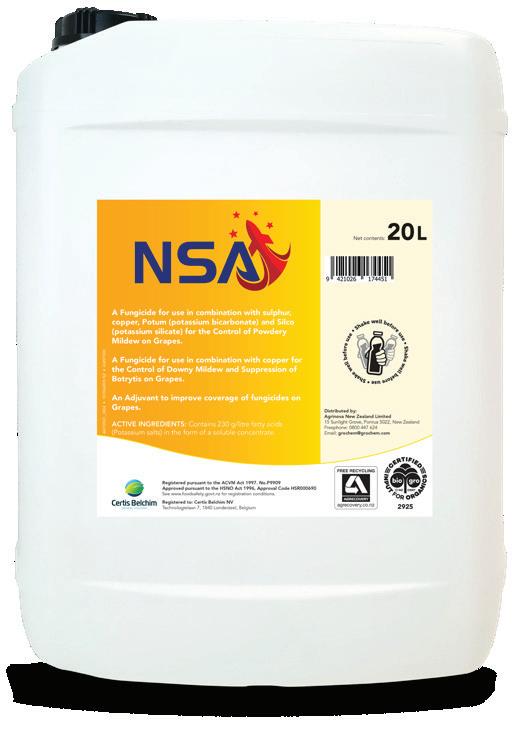

company in New Zealand and Josh says the certification helps demonstrate ESG values in an internationally recognised way and appeals to consumers in offshore markets. “They make associations between our company and other B Corps in the US with it. It’s a good look.” It also aligned with the values of the founders of Tiraki. As fifthgeneration farmers, the Hammond family are keen to see the land providing for five more generations and continue to contribute to Marlborough’s strong community.
“The B Corp certification offers a level of credibility to these values in a similar way that Biogro certification adds credibility to an organic producer,” says Josh.
NSA is an innovative protective and curative fungicide that protects against Powdery and Downy Mildew.
Benefit from enhanced spreading, easy handling, and consistent viscosity without pre-mixing. With unmatched versatility - easily tank mix with Nordox or Norshield, Sulphur, Potum or Silco for seamless crop management. NSA with an organic certification, is an eco-friendly ally for optimal grape health and yields.
Contact your Grochem Sale Representative, Viticulture Specialist or visit grochem.com to embrace the future of grape cultivation.
NIGEL SOWMAN, grape grower representative, viticulturist for Dog Point Vineyards.
With vines greening up and the threat of frost hopefully over, I can’t help but think about potential crop load. But this was not always the rhetoric – looking back to before the 2008 crash/glut and the talk was how good is the quality of your grapes, or what blend you made it into.
Since then the industry has boomed as new markets were found on the back of the need to sell greater stocks of wine. Wineries became short of fruit to supply these markets so for the first time yield caps on growers largely disappeared, and the rhetoric became “I cropped this high” and pride of quality fell down the priority list. Add to that the fast-rising cost of production and another fall in grape prices, and crop load has now become the marker for viability and profitability for many growers. I’ve been thinking about the questions in the recent Wine

Marlborough survey to growers and wineries: What size crop can you fit in your winery? Do you have uncontracted fruit? Add to this the NZ Winegrowers stats that very little 2024 wine has been sent out, and winery tank capacity must be constrained.
Will we see a return to yield caps/quality parameters? Will fruit be left on the vine? I think the rhetoric this year should be keep it clean and the quality high. Make sure you give yourself the best chance of getting harvested.

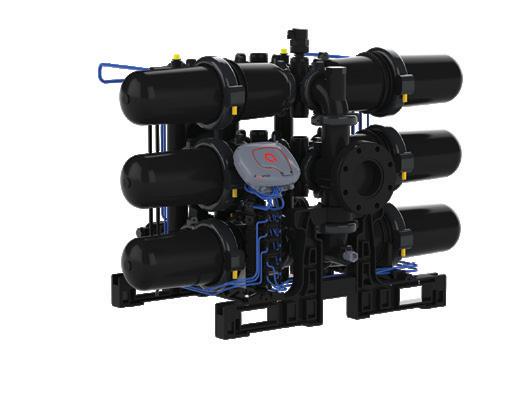


For more information contact Water Supply Products: Auckland: 09-916 0094 Christchurch: 03-348 1293 wsp@watersupply.co.nz www.watersupply.co.nz
Marlborough’s Young Viticulturist of the Year took top national honours for biosecurity planning
SOPHIE BADLAND
FOR SUSTAINABLE Winegrowing New Zealand (SWNZ) vineyard members, having a vineyard biosecurity plan in place will be a requirement for certification from the 2026 audit season onwards. As part of the Young Viticulturist of the Year national final this year, the six contestants were tasked with creating a biosecurity plan for an unfamiliar vineyard, as well as developing a plan for implementation. Anna Kelland, Viticulture Technician for Constellation Brands in Marlborough, won this section of the competition with a well-researched, thorough plan and guidance for implementation.
About 65% of SWNZ vineyard members indicate they already have a biosecurity plan in place for their vineyards ahead of the 2026 deadline. Anna’s view is that although this is another task and may take some time and resource for growers to implement, it is justifiable given the potential consequences of not being prepared for a serious incursion. “Requiring a basic plan will make sure everyone is on the same page. Industry-wide biosecurity awareness will benefit us all. It’s also a good opportunity to learn more about the threats that could come into the country.” Developing a basic vineyard biosecurity plan also provides a professional development or training opportunity for up-and-coming leaders, along with experience in risk analysis, planning and risk mitigation.
Coming into the Young Vit competition, some elements of biosecurity were new to Anna but as pest and disease monitoring is part of her role at Constellation she had a head start and knew where to find the relevant information.

“It was a big task, and we only had a short time to research, put together a plan and the associated budget. I initially focused on research and understanding the background information to inform the process of developing a plan.”
Part of the task involved reviewing options, undertaking a cost-benefit analysis, and calculating return on investment in a worst-case scenario of a biosecurity incursion taking out 50% of the crop, within five years of a biosecurity plan being implemented. Anna said there was a clear return on investment. “Even with some capital investment and ongoing costs of implementation, it’s a solid investment and you can’t justify ignoring it. The assumption in the task was that having the plan in place would protect your vineyard, but even if it prevented just some of the damage and crop loss in a real-life situation, you’d still be better off than not having those mitigations in place.”
Developing a plan is all very well, but unless it is implemented it doesn’t reduce biosecurity risk to a vineyard. “It’s about getting everyone involved, getting that buyin. Education, communicating with staff and contractors about why we are doing this, their role in the plan, and making it accessible to everyone is really important, and use mechanisms that work for the people you are working with. For example, there are some really high-tech systems out there, but if most of your staff are older and don’t use apps, it may not be a practical solution for your business. Making






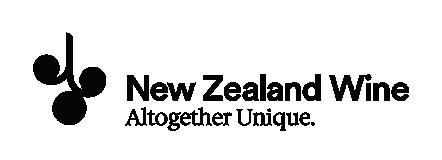
it accessible to workers and building on familiar processes will help it succeed.”
Asked about the key learnings she took from her research, Anna noted the far-reaching impacts that serious biosecurity incursions can have on primary producers, communities and the country as a whole. “The broad reach of some of these exotic pests and diseases won’t affect just viticulture and the New Zealand wine industry, but also the wider horticulture sector and our economy. And the knock-on effects – vineyards mothballed, people out of jobs, impacts on the environment and native species. Also figuring out what’s involved in a large biosecurity response – the role of MPI and NZ Winegrowers, the impacts of movement controls, potentially not being able to move grapes or equipment between regions at harvest. The impacts can really snowball.”
For those getting started with developing a biosecurity plan, Anna recommends spending time doing some research as a first step. “A good place to start is the NZ Winegrowers website, resources, factsheets and guides. I’d also recommend reading wider, to understand the implications of biosecurity threats beyond just the vineyard level. Go to conferences, talk to other industry members who have experience with biosecurity plans. Think about the risk pathways relevant to your vineyard - for example, Picton and Napier are port towns which means cruise ship passengers coming into vineyards are a potential biosecurity risk pathway. While some aspects of biosecurity planning will be pretty standard to all vineyards, different approaches are also needed to manage different risk pathways, and these will vary for businesses depending on their operating
“Know your enemy - especially when it could decimate your industry.” Anna Kelland

models.” When asked for any final thoughts on biosecurity for the wine industry, Anna’s response was clear: “Know your enemy – especially when it could decimate your industry.”
New Zealand Winegrowers congratulates Anna and all the Young Viticulturist national finalists for their fantastic work on the biosecurity project in the competition.
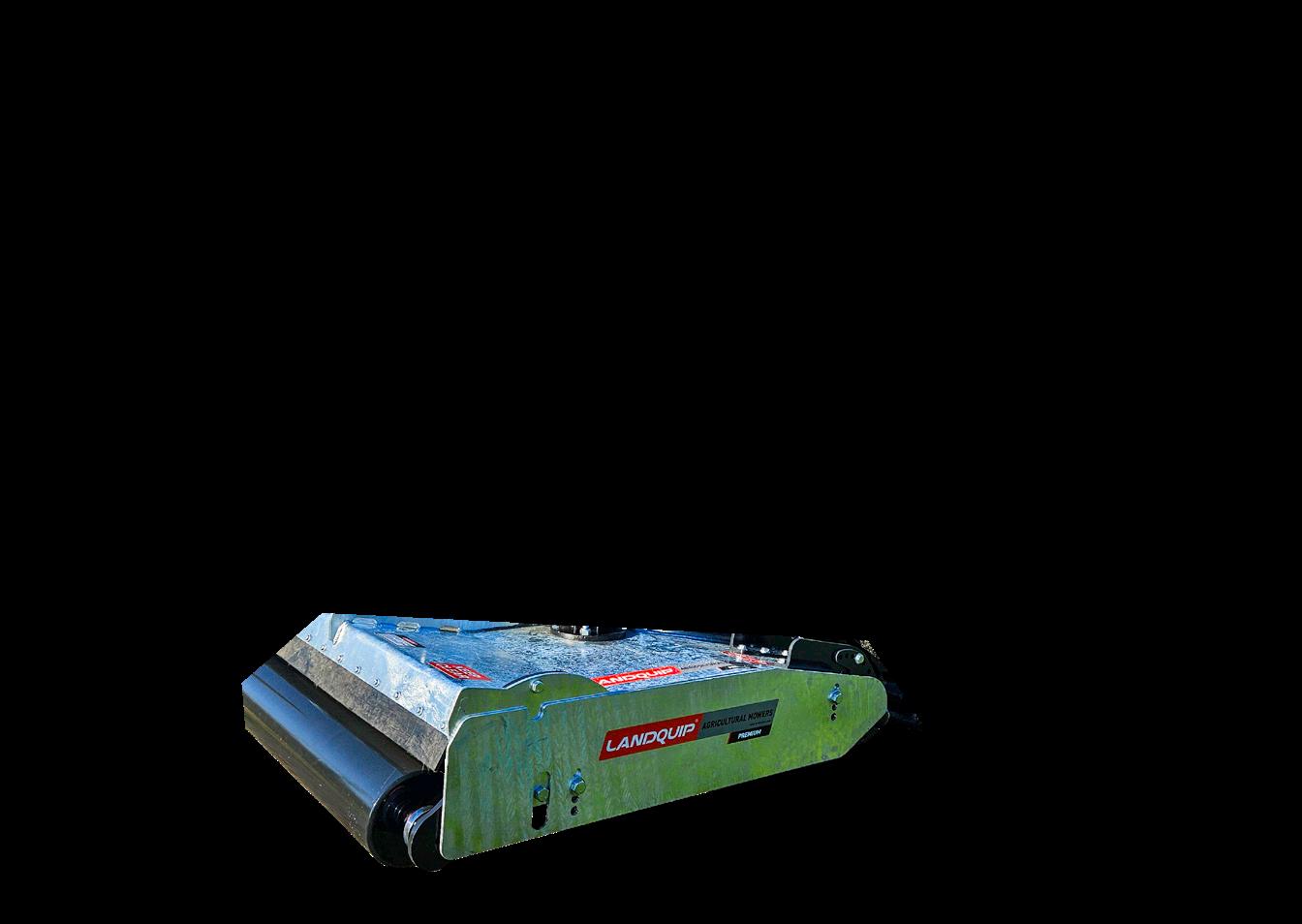















A new level of Botrytis and Powdery Mildew control with one-drum
MIRAVIS® Prime fungicide combines the power of ADEPIDYN® technology with proven fludioxonil to deliver:
• Powerful and long-lasting control of Botrytis and Powdery Mildew in grapes;
• Two modes of action for Botrytis resistance management;
• Excellent rainfastness.
For export wine PHIs consult your winery or refer to the latest New Zealand Winegrowers Vineyard Spray Schedule.

Scan for more information, visit www.syngenta.co.nz or talk to your local distributor.


®
From recycled plastic vineyard posts to electric tractors, wine-related companies are among those who have put their names forward for the 2025 Port MarlboroughMarlborough Evironment Awards.
Thirty-one entries have been received across eight categories: Wine Industry (sponsored by Wine Marlborough), Electrification & Energy Efficiency, Community Innovation, Landscape and Habitat, Farming, Forestry, Marine and Business Innovation. The Awards encourage Marlborough businesses and community groups to share their experience in looking after the environment through restoration projects, waste management, carbon reduction and efficient use of resources.
Among this year’s entrants are FuturePost, who collect waste plastic from vineyards around the region and recycle it into vineyard posts as an alternative to chemically treated wooden posts. Wairau River Wines have entered their project to reduce liquid waste from their winery processes, with improved wastewater treatment and removal of biosolids. Dynes Transport are showcasing a hybrid hydrogen-diesel truck that reduces CO2 emissions by up
to 40%, and is used to cart grapes during harvest. TRS Wholesale have entered a fully electric vineyard sprayer powered by a carbonzero electric tractor. Hortus has two entries focused on its worker accommodation – turning food waste from the kitchens into compost for vineyards; and the installation of 230 heat exchange ventilation units to control moisture and conserve energy.

Jo Grigg, Chair of the Marlborough Environment Awards Trust, is delighted with the high number of entries across all categories. “Many of the ideas and work done can be applied across a range of our local industries and landscapes – for example what’s being done on pastoral farms has application for vineyards; habitat enhancement in our marine areas has common threads with land enhancement work.” Judging starts this month and winners will be announced in April.
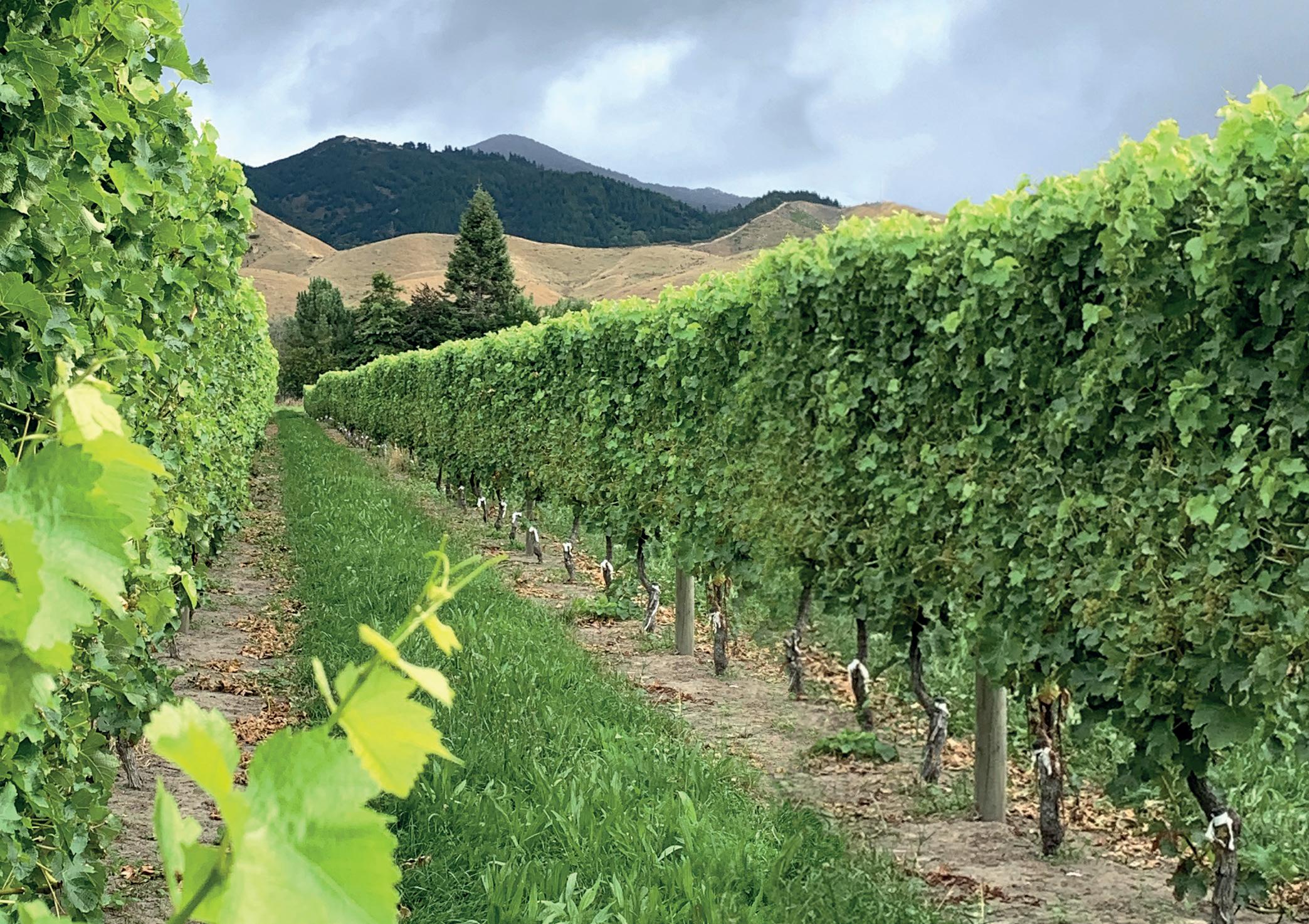
For strong vines, consistent yields and better tasting wines*apply:
– to improve foliar health and resilience in times of environmental stress
*Asusedin2021AccoladeWinestrial for provenyieldincreaseandbettertastingwine. Mycorrcin – to boost soil microbes that increase root growth and nutrient uptake Digester – to stimulate decomposition microbes to recycle organic matter fast




A passion project that began in 2020 to give back to RSE worker communities in the Pacific has grown into the Village to Village Charitable Trust, with several wine companies on board as sponsors. Cloudy Bay, Tūpari Wines and Dog Point Vineyard are supporting projects including the Good Pick Fund, which provides mentorship and zero interest loans to fund business startups back in a worker’s home village.
Another initiative supplies solar-powered stoves for clean cooking, rather than burning trees for fuel. The stoves save time and reduce exposure to smoke and fumes, and its solar battery can also charge mobile phones and run lighting. Trustee Jim White says both projects help build long-term prosperity in Pacific communities and the trust is keen to do more.
Cloudy Bay and Village to Village are hosting a launch and fundraising event on November 27 to raise awareness about the trust’s projects and to encourage new sponsors to join. Jim says RSE workers are the unsung heroes in the growth of the Marlborough wine industry: “The workers and their families make significant sacrifices coming to New Zealand – they leave behind wives, husbands, children and their community for extended periods to provide better
An environmentally friendly option isn’t helpful if it doesn’t do the job it needs to. PolyNatural vine clips are developed to be durable enough to hold nets in place to protect your harvest. And when the job is done, they’ll safely and simply return to the earth.
Order now for the upcoming growing season at polynatural.nz/shop

financial support for their families. Without the RSE scheme our wine industry and region would wither. In return for the contribution they make to our communites, we want to help them help their communities.”
Village to Village launch and fundraiser – wine, food and inspiring stories, Cloudy Bay Cellar Door, 27 November 7pm-10pm. $150 + GST ($100 from each ticket goes to Pacific projects.) To buy tickets: manager@villagetovillage.org.nz

Appellation Marlborough Wine has announced its 2024 Annual Collection of top 12 Sauvignon Blancs. AMW was established to protect the reputation of Marlborough wine and has more than 55 member companies who meet the organisation’s standards for quality, provenance and sustainability. Chair of the Collection judging panel Stephen Wong says the 2024 wines were very expressive but also had beautifully balanced fruit. “From what we tasted producers should be proud of how complex and sensitively handled many wines were.” The 12 selected wines are:
• Ahi Kā Blackmore Sauvignon Blanc 2024 (Dillons Point, Lower Wairau Valley)
• Astrolabe Marlborough Sauvignon Blanc 2024 (Marlborough)
• Auntsfield Natures Path Sauvignon Blanc 2024 (Ben Morven, Southern Valleys)
• Dog Point Vineyard Sauvignon Blanc 2024 (Southern Valleys, Wairau Valley)
• Georges Michel Sauvignon Blanc 2024 (Lower Wairau Valley)
• Huia Sauvignon Blanc 2024 (Wairau Valley)
• Isabel Single Vineyard Sauvignon Blanc 2024 (Wairau Valley)
• Nautilus Sauvignon Blanc 2024 (Marlborough)
• Pretty Paddock Sauvignon Blanc 2024 (Lower Wairau Valley)
• ROHE Blind River Sauvignon Blanc 2024 by Rapaura Springs (Blind River)
• Starborough Sauvignon Blanc 2024 (Awatere Valley)
• Whitehaven Block 11 Barrel Fermented Sauvignon Blanc 2023 (Rapaura, Central Wairau Valley)

GRAPES WANTED
High quality Sauvignon Blanc grapes required to satisfy growing export demand.
Other varieties considered. Contracts for 2025 and beyond. Phone Ant Mackenzie 021502996
FOR LEASE
Hawkesbury Boutique Vineyard for lease from 5/25. Clone 3309 Sauvignon Blanc. 2.5Ha north facing slope averaging 29.8T/Ha over ten years. Please contact northfacingvineyard@gmail.com
Nelson Grapes for Sale: 7t Pinot Gris 2025, 5t Pinot Blanc 2025, 14t Pinot Noir 2025, 24t Sauvignon Blanc 2025 Nelson Wine for Sale: 3200L Sauvignon Blanc 2024, 1000L Pinot Gris 2024
Please contact Daniel - Blackenbrook Vineyard Phone 027 640 2550 wine@blackenbrook.co.nz

A monthly list of events within the New Zealand wine industry. To have your event included in the December 2024 Wine Happenings, please email details to editor@winemarlborough.nz by November 20. For more information, go to the website supplied or email sarah@winemarlborough.nz
NOVEMBER
20 Vines Village monthly market (marlboroughnz.com/events/vines-village-monthly-market)
21 Pre-Harvest Summit, MRC Theatre, RSVP required (marlboroughwinenz.com)
23 Savour in the Park festival, Pollard Park (savourmarlborough.co.nz)
24 Grape & Gravel Bike Race, Marisco Family Vineyards (marisco.co.nz)
25 NZ Wine Centre, Research Snapshots (marlboroughwinenz.com/industry-events)
26 A Taste of Research: Pinot Noir, Bragato Research Institute (nzwine.com)
27 Village to Village Launch and Fundraiser, Cloudy Bay Cellar Door (villagetovillage.org.nz)
DECEMBER
3 Blind wine-tasting challenge, Fidelo Wine Bar (fidelio.co.nz/up-coming)
18 Vines Village monthly market (marlboroughnz.com/events/vines-village-monthly-market)
JANUARY
31 Blood Sweat & Beers Mountain Bike Race (matt@marisco.co.nz)

Fundraiser event – Nov 27









Supports the plant in the crucial phases of flowering and fruit setting in optimal and suboptimal environmental conditions.
MC SET is a formulation based on active phytoingredients extracted from the algae Ascophyllum nodosum
The complex of biomolecules gives the product a considerable capacity to stimulate the flowering and fruit setting processes.
MC SET increased the activation of genes involved in specific physiological functions of flowering and fruit setting. (As per TAIR description - www.arabidopsis.org).












• Ability to accurately measure and apply fertiliser with even


• Utilise the latest GPS Aerial Application







• Ability to work when ground conditions are not favourable.


Providing a high level of Botrytis and powdery mildew control
Miravis® Prime delivers powerful control of Botrytis and powdery mildew in wine grapes. Talk to your local Fruitfed Supplies team for more information on using Miravis® Prime » ACVM #P009724. Read registered label before use.

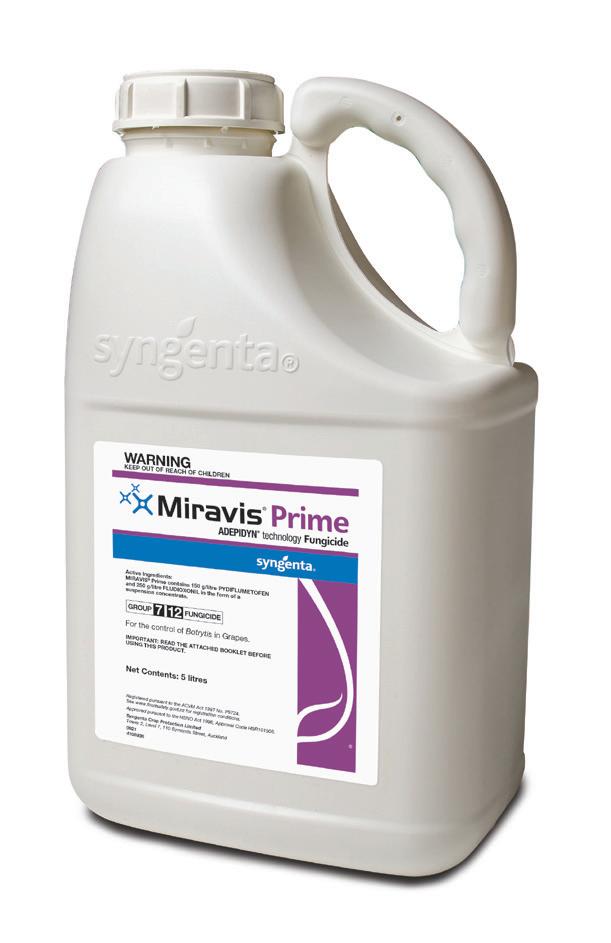


www.fruitfedsupplies.co.nz


